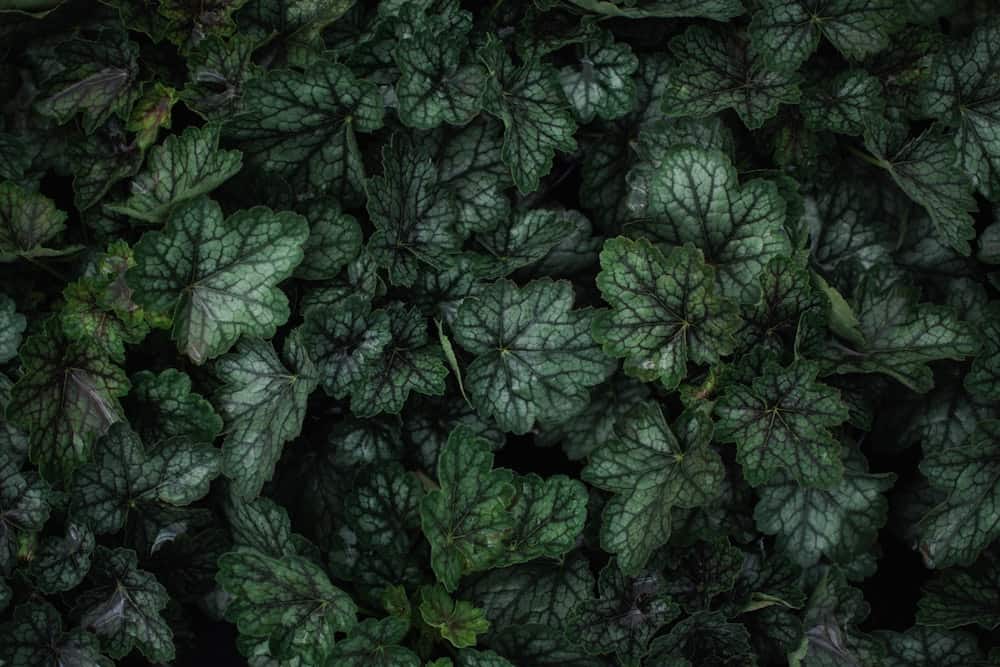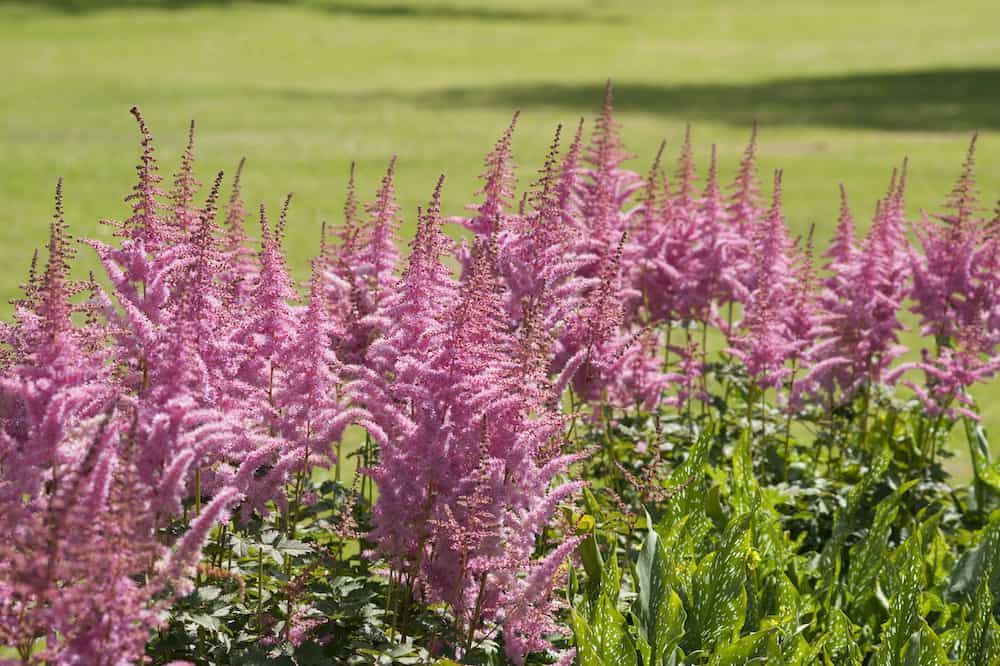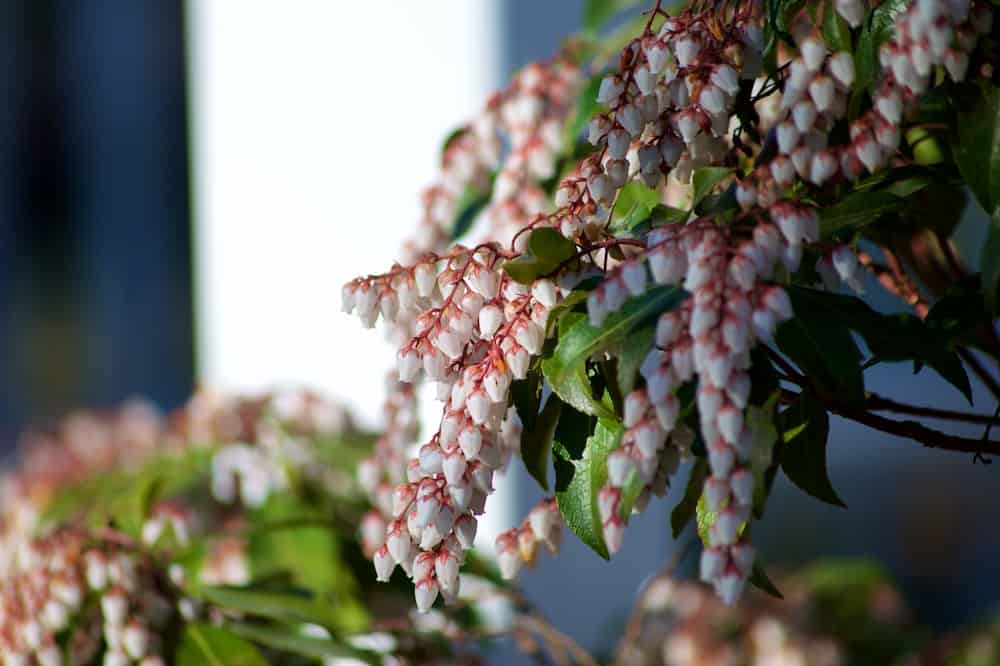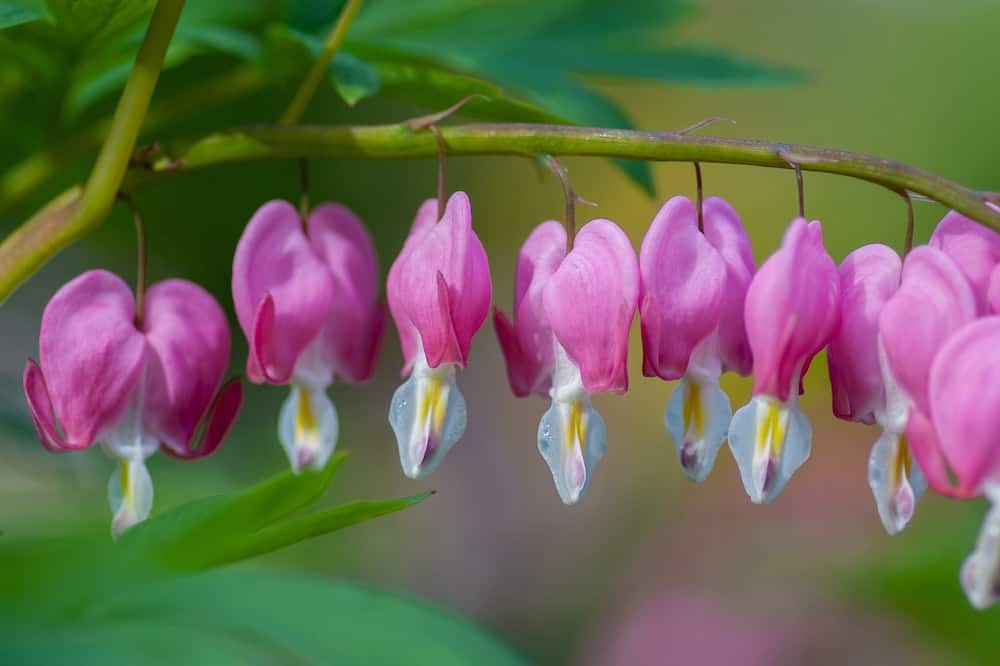Shade plants are plants that grow well in shade. They are considered shade tolerant and don’t require full sun to thrive. This means even in low-light areas of your yard, you can still have a thriving garden.
They include evergreen or deciduous shrubs, annuals, perennials, ground covers, and vines.
Some examples are ferns, hostas, and foxgloves, which are perfect for under trees or in north-facing gardens. For those really shady spots, bleeding hearts are an excellent choice as they thrive in full shade. Plants like impatiens and hydrangeas need some sun and grow best in partial shade.
If you’ve got a shady area in your yard where nothing seems to grow, planting shade-loving plants will change that. These plants typically prefer moist, well-drained soil. Adding mulch can help hold moisture, which can be especially beneficial for some types.
In drier climates or in parts of your property that are more arid, you might want to consider drought-tolerant shade plants, like lungwort and hardy varieties of cyclamen. More on this below.
Reasons to Plant Shade Plants
Planting shade plants isn’t just about covering up patches of dirt; it’s also about supporting the local ecosystem. They contribute to biodiversity and help with soil health and erosion control. Depending on your property’s needs, you may find it beneficial to reroute rainwater toward a raingarden in a shady area you fill with moisture-loving plants.
Here, I explain plants that flourish in shady areas and how they can transform your garden. Some are excellent ground cover as well.
Identifying Shady Areas in Your Yard
Before choosing what to plant, it’s important to know which areas of your property are shaded and may benefit from some green. Common spots include:
Under large trees: These spots typically receive dappled sunlight but can be quite shady.
North-facing sides of buildings: These areas rarely get direct sunlight.
Along fences or walls: Depending on their orientation, these areas can be in partial to full shade.
Under shrubs or dense bushes: These create microclimates of shade.
Understanding Full Shade vs Partial Shade
You may be familiar with “full sun” when planting fruits and vegetables. It’s defined as being 6 or more hours of direct sunlight each day. Shade has criteria as well. Some areas will be more shady than others.
It’s important to know how much shade the area gets so you can plant the correct types of plants. Not all shade plants are alike. Some need more shade than others.
Decide which shady areas you’d like to spruce up with plants. Then, on a sunny day, observe how much sun the areas get.
Different Types of Shade
- Deep Shade or Full Shade
These areas receive little or no direct sunlight. Generally, full shade means less than 3 hours of direct sunlight daily throughout the day.
Note, even shade plants need some sunlight to grow. If an area receives zero sun or filtered sun, do not plant there.
Plants to plant in full shade: Ferns like dryopteris and polystichum, Solomon’s seal, and Canadian wild ginger, hart’s tongue are ideal. Other full shade plants include Japanese forest grass, primrose, and foamflower.
Oakleaf hydrangeas will grow in full shade and are adaptable to different sun and shade conditions.
- Partial Shade
Consider an area to be partially shady if it receives 3 – 6 hours of sun per day. These areas should not be sunny during the hottest part of the day.
Plants that do well in partial shade are Hostas, astilbe, and foxgloves.
- Light Shade
You can consider an area to have light shade if it receives filtered sun. These areas receive partially filtered sunlight or dappled sunlight for part of the day. An example is under trees with open canopies. The amounts of sun and shade will vary throughout the day.
Plants that thrive in light shade include impatiens, hydrangeas, and coral bells.
Shade Plants by USDA Hardiness Zones
No matter what you are planting, considering your climate is hugely important to the success of your plants’ growth. Knowing your USDA hardiness zone is a key factor in selecting plants. This system divides North America into 13 zones based on the average annual minimum winter temperature. For example:
Zones 3 – 5: These colder zones need hardy plants like Siberian bugloss, bleeding hearts, and Canadian wild ginger.
Zones 6 – 8: Try plants that can handle moderate winters such as Japanese anemone, oakleaf hydrangea, or autumn ferns.
Zones 9 – 11: Plants that can tolerate warm-to-hot temperatures in these zones include clivia, maidenhair ferns, and hellebores.
These climates have differing humidity and rainfall averages. Selecting the right plant for your region may mean you won’t have to water as frequently because the rainfall will be enough.
As an example, on average, climate zones 3 – 5 will have higher humidity and rainfall throughout the year than zones 9a and 9b.
Moisture Requirements and Care
Knowing your climate zone will also help you choose plants suitable for your region in terms of moisture. Shade plants are typically hardy but some may need more care than others.
My Experience Not Watering Hostas
When I lived in the Midwest, we had thriving hostas that we never maintained. They were planted by the previous owner. They surrounded the mighty trees in our west-facing yard. (We added mulch every third year or so.)
Hostas also lined our driveway. My husband actually chopped them down several times (he didn’t like them by the driveway), and they came back stronger than ever (which was quite funny!). We never watered them… ever!
I hope this experience shows that planting the right kind of shade plants for your climate is really important. For me, the lower the maintenance, the better!
Using a Moisture Meter
You may want to use a moisture meter to check the moisture of the soil where you want to plant. You can buy a decent moisture meter for less than $20 at home improvement stores such as Ace Hardware, Home Depot, Lowe’s, and Menards. You may also find them at Walmart and on Amazon.
A simple moisture meter has a probe you stick in the ground (preferably when it hasn’t rained) to check how moist the soil is.
Plants for Damp Shade
Some shade plants need consistently moist soil. Some that are known to well in damp conditions include ferns and ligularia. Here are some other examples of shade plants that grow in damp shade:
Groundcover:
- Bunchberry
- Canby pachistima
- Checkerberry
- Japanese spurge (evergreen)
- Yellowroot
Vining
- Woodbine
Herbaceous Perennials
- Black snakeroot
- Canada lily
- Cardinal flower
- Cinnamon fern
- Fringed loosestrife
- Great blue lobelia
- Interrupted fern
- Lady fern
- Marsh marigold
- Pink turtlehead
- Royal fern
- Solomon’s seal
- Virginia spiderwort
- White turtlehead
- Yellow wax-bells
Annuals
- Forget-me-not
- Nemesia
Dry Shade Tolerant Plants
Some examples of plants that can do well in dry ground are:
- Fern robust male: Once established, it’s drought tolerant. This is a robust plant that can grow tall and wide. Needs room to spread. In warmer climates it’s evergreen.
- Hosta blue mouse ears: This is a miniature hosta with lavender flowers that are bell-shaped. Hostas do well at the base of trees because they can grow well with tree roots. Incorporating these mini hostas with full size makes a nice display.
- Pachysandra green carpet: This will provide a dense evergreen ground cover.
- Spotted dead nettle: Blooming groundcover; can plant with hostas and ferns for nice variety.
- Vinca sterling silver: These produce blue flowers. Quick growing, it roots along it’s vining offshoots, forming a dense spreading evergreen ground cover. Grows well under deciduous trees that provide partial-to-full shade. Excellent for erosion control as well.
These plants are low maintenance and can survive with minimal watering once established. Other plants include epimedium and sedum.
Shade Plant Types for Specific Purposes
As ground cover:
- Plants: Pachysandra, sweet woodruff, and vinca minor
- Benefits: They cover bare spots well and can help prevent soil erosion.
Shrubs for shade:
- Plants: Rhododendrons, azaleas, hydrangeas (prefer afternoon shade), and boxwood
- Benefits: These shrubs add structure and height to a garden.
Perennials:
- Plants: Hellebores, columbine, bleeding hearts, and toad lily
- Benefits: They bloom seasonally, yearly
Visual appeal with flowers
- Plants: Examples include bleeding heart, columbine, lungwort, impatients, hellebore, and trillium.
- Enhance a shady area with colorful blooms
How Plants Adapt to Grow in Shade
You might wonder how plants can grow without much sunlight. Shade plants are specially adapted to capture the limited light available.
- Large leaves: Allow them to capture more light
- Rich chlorophyll content: Maximizes photosynthesis
- Early growth: Many bloom early in the spring before trees grow their full leaves
Encouraging Biodiversity
Certain shade plants can attract beneficial insects, including bees, and birds, which will help the environment. Be mindful they can also attract wildlife, some of which you may not want to attract.
Other Considerations for Shade Gardening
Soil type: Check if your soil is clay, loam, or sandy. Some shade plants prefer rich, loamy soil.
Local wildlife: Be aware of which plants might attract or deter local wildlife.
Maintenance: Consider how much time you’re willing to spend on upkeep. Some shade plants require more pruning and care than others.
Shade Plants Perennials
Consider some of these rugged, hardy plants. According to Clemson University, some perennials to consider are:
- Anemone
- Astilbe
- Bear’s Breech
- Bleeding Heart
- Blue Star
- Cardinal Flower
- Columbine
- Coral Bells
- Dead Nettle – Grows well in hardiness zones 4 – 10
- Fairy Bells
- Ferns such as Japanese Painted Fern
- Foxglove
- Great Blue Lobelia
- Hardy Cyclamen
- Hosta
- Hydrangea – Perennials in hardiness zones 3 – 7
- Japanese Yellow Sage
- Lady’s Mantle
- Lily of the Valley
- Meadow Rue
- Plantain Lily
- Plumbago
- Virginia Bluebells
- Wild Gingers
- Wild Sweet William
Best Perennials Shade Plants
I’ve picked these as my best perennials to grow in the shade because they are quite hardy. I favor perennials because they are low-maintenance, and you won’t need to replant the area.
My top choices are: Coral Bells, Astilbe, Andromeda, and Bleeding Heart.
Hart’s Tongue Fern
Growing well in hardiness zones 5 – 9, hart’s tongue fern grows to a height of 1 – 1.5 feet and a spread of 1 – 1.5 feet. This is a non-flowering plant that thrives in partial to full shade. It’s a low maintenance evergreen that requires medium watering.
Coral Bells: Best Shade-Friendly Plant for Beginners

Most gardeners will agree that it’s difficult to find a more reliable perennial plant than coral bells. Plant coral bells once, and they will flourish when the weather starts to get warmer, time and time again. They are hardy and do well in shade.
The colorful foliage found on this plant is usually what attracts most people to it, but some varieties also have colorful flowers on tall, showy stems.
Coral bells are easy to grow and maintain, which is great news for those of us who appreciate having a beautiful garden with the least work possible. They are also ideal perennials for beginner gardeners.
You can plant your coral bell seeds in early spring or late fall by sprinkling them straight onto the ground and covering them lightly with soil.
Hardiness zone for coral bells: Most varieties grow in hardiness zones 4 – 8. However, check the exact variety at your garden center or nursery.
Astilbe: Best Shade Plant for Butterfly Lovers

Although many plants attract butterflies, some of them require full sun. If you’re looking for a shade-tolerant perennial that attracts butterflies, as well as other beneficial insects to your garden, then look no further than the beautiful astilbe plant.
The astilbe plant also has the added benefit of being really easy to grow. It looks really good when planted along paths and in borders, as well as in pots. They are ideal in large pots in shady locations.
During midsummer, astilbe will brighten your shady spot with deep green, fern-like foliage, teamed with white, pink, red, lavender, or violet flowers, depending on the variety. You can plant your astilbe seeds in spring when the ground is cool and moist.
Hardiness zones : Growing zones 3 – 9 for most varieties of astilbe.
Andromeda: Best Shade-Loving Bush

If you’re wondering what bushes grow in the shade, then check out our favorite shade-tolerant bush: the andromeda. Bushes are also perennial, and some will even flower at various points in the year, including this one. This beautiful landscape plant is an evergreen shrub that does well in light shade.
The andromeda is a shade-tolerant bush that can offer the best of both worlds by sprouting fragrant flowers in the summer, as well as providing year-round evergreen foliage.
Also known as the lily of the valley bush, it doesn’t fare too well in alkaline soil, so you may need to adjust the pH of your soil before planting. It will thrive in sandy or peaty moist, cool soil.
It’s well worth the trouble, though, and we’re confident you’ll never get bored of the ever-changing face of this shrub.
You can plant your andromeda bush in spring or summer, but be sure to give it a bit of room since it can grow to around 10 feet tall. This can be a benefit to creating borders, various spaces, and privacy on your property. They can also work to keep animals out without fences.
Growing zone for andromeda plants: 5 – 9
Bleeding Heart: Best for Full Shade

An old gardener’s favorite, Bleeding heart thrives in heavy shade. Therefore, if you have a patch in your garden that is rarely in full sun, this plant will still work really well.
They really are stunning to look at, especially with their inch-long heart-shaped flowers dangling from their arched stems. Bluish-green foliage will emerge first, and then the pink with white or white flowers will appear in early spring. They will also attract hummingbirds.
The bleeding heart is a herbaceous perennial and will start to wither away as the full heat of summer arrives, storing energy in order to sprout again next year.
You can plant your bleeding hearts in spring or fall and fertilize in early spring to encourage a higher number and longer-lasting blooms. Bleeding hearts make a great shade border and filler plant. It requires well draining, moist soil.
Hardiness zone: They grow well in zones 3 – 9.
Shade-Loving Plants
Choosing the right shade plants for your yard depends on understanding your local climate, the type of shade you have, and the soil conditions. Whether you’re looking to cover bare spots, add greenery under trees, or help with erosion control, there’s a shade plant that can meet your needs.
You may also want to consider choosing plants with varying heights for visual appeal. Consider also planting shade plants that flower to liven up shady areas.
In conclusion, shade plants are a great way to add some color and life to any yard or garden.
References:

